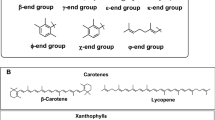Abstract
For the main component of the pigments ofErwinia rubrifaciens, we suggest the hitherto unknown structure of a 3-(3-carboxymethyl-4,5-dihydro-4,5-dioxo-2-pyrrolyl)-4,5,6-trihydroxy-pyridine-2-acetic acid. Its isolation and characterization are described. Inasmuch as arylpyrrolindiones are known to be red, the proposed structure can account for the color of the pigment. The 2,3,4-trihydroxypyridine moiety probably inhibits the electron transport in mitochondria. This could explain the toxic action ofErwinia rubrifaciens onJuglans regia.
Similar content being viewed by others
Literature Cited
Antkowiak, W. Z., Gessner, W. P. 1979. The structures of orellanine and orelline. Tetrahedron Letters20:1931–1934.
Barker, W. R., Callaghan, C., Hill, L., Noble, D., Acred, P., Harper, P. B., Sowa, M. A., Fletton, R. A. 1979. G1549, a new cyclic hydroxamic acid antibiotic, isolated from culture broth ofPseudomonas alcaligenes. Journal of Antibiotics32:1096–1103.
Chatterjee, A. K., Brown, M. A. 1981. Chromosomal location of a gene (idg) that specifies production of the blue pigment indigoidine inErwinia chrysanthemi. Current Microbiology6:269–273.
Feistner, G., Budzikiewicz, H. 1984. On the structure of rubrifacine. Canadian Journal of Chemistry61 (in press).
Feistner, G., Korth, H., Ko, H., Pulverer, G., Budzikiewicz, H. 1983. Ferrorosamine A fromErwinia rhapontici. Current Microbiology8:239–243.
Findlay, J. A., Krepinsky, J., Shum, A., Casinovi, C. G., Radics, L. 1977. The structure of isoflavipucine. Canadian Journal of Chemistry55:600–603.
Gherna, R. L., Richardson, S. H., Rittenberg, S. C. 1965. The bacterial oxidation of nicotine. VI. The metabolism of 2,6-dihydroxypseudooxynicotine. Journal of Biological Chemistry240:3669–3674.
Hall, C., Wu, M., Crane, F. L., Takahashi, H., Tamura, S., Folkers, K. 1966. Piericidin A: a new inhibitor of mitochondrial electron transport. Biochemical and Biophysical Research Communications25:373–377.
Holmes, P. E., Rittenberg, S. C., Knackmuss, H.-J. 1972. The bacterial oxidation of nicotine. VIII. Synthesis of 2,3,6-trihydroxypyridine and accumulation and partial characterization of the product of 2,6-dihydroxypyridine oxidation. Journal of Biological Chemistry247:7628–7633.
Hwang, D. R., Driscoll, J. S. 1979. Pyridones as potential antitumor agents. Journal of Pharmaceutical Sciences68:816–819.
Itoh, J., Amano, S., Ogawa, Y., Kodama, Y., Ezaki, N., Yamada, Y. 1980. Studies on antibiotics BN-227 and BN-227-F, new antibiotics. II. Chemical structure of antibiotics BN-227 and BN-227-F. Journal of Antibiotics33:377–382.
Knackmuss, H.-J. 1973. Zur Chemie und Biochemie der Azachinone. Angewandte Chemie85:163–169.
Medina, E., Spiteller, G. 1979. Konstitutionsaufklärung des Melochinins, eines Pyridon-Alkaloids neuen Typus ausMelochia pyramidata L. (Sterculiaceae). Chemische Berichte112:376–383.
Schaad, N. W., Heskett, M. G., Gardner, J. M., Kado, C. I. 1973. Influence of inoculum dosage, time after wounding, and season on infection of Persian walnut trees byErwinia rubrifaciens. Phytopathology63:327–329.
Starr, M. P. 1981. The genusErwinia, pp. 1260–1271. In: Starr, M. P., Stolp, H., Trüper, H. G., Balows, A., Schlegel, H. G. (eds.), The procaryotes. New York: Springer-Verlag.
Starr, M. P., Cosens, G., Knackmuss, H.-J. 1966. Formation of the blue pigment indigoidine by phytopathogenicErwinia. Applied Microbiology14:870–872.
Wilson, E. E., Zeitoun, F. M., Fredrickson, D. L. 1967. Bacterial phloem canker, a new disease of Persian walnut trees. Phytopathology57:618–621.
Yoshida, S., Nagao, Y., Watanabe, A., Takahashi, N. 1980. Structure-activity relationship in piericidins inhibitors on the electron transport system in mitochondria. Agricultural and Biological Chemistry (Tokyo)44:2921–2924.
Yoshida, S., Shiraishi, S., Takahashi, N. 1977. The structural revision of piericidin A by combination of CMR spectroscopic and biosynthetic studies. Agricultural and Biological Chemistry (Tokyo)41:587–591.
Yoshida, S., Yoneyama, K., Shiraishi, S., Watanabe, A., Takahashi, N. 1977. Chemical structures of new piericidins produced byStreptomyces pactum. Agricultural and Biological Chemistry (Tokyo)41:855–862.
Author information
Authors and Affiliations
Rights and permissions
About this article
Cite this article
Feistner, G., Korth, H., Budzikiewicz, H. et al. Rubrifacine fromErwinia rubrifaciens . Current Microbiology 10, 169–172 (1984). https://doi.org/10.1007/BF01576780
Issue Date:
DOI: https://doi.org/10.1007/BF01576780




